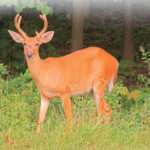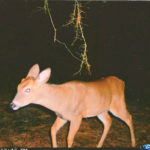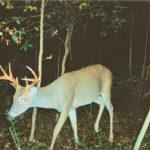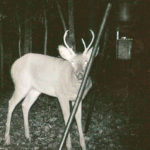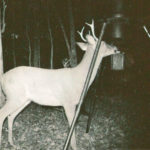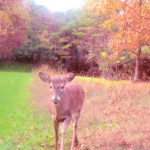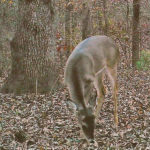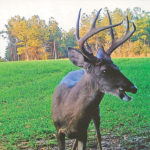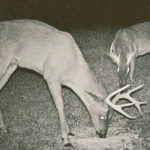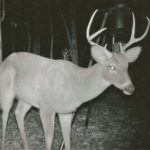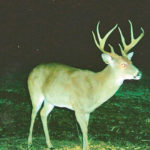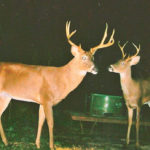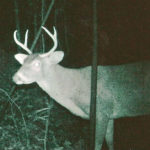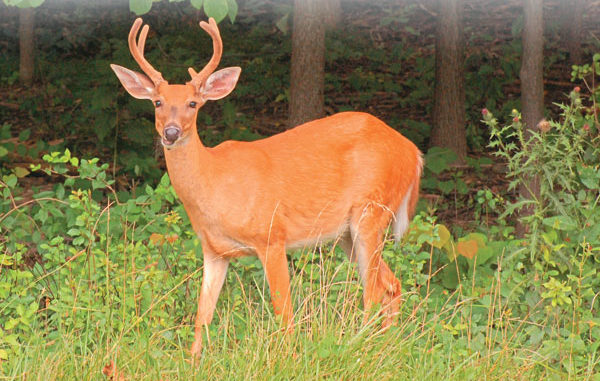
Decisions you make during deer season greatly impact herd
Most deer hunters in Louisiana by now should know something about Quality Deer Management (QDM). It has been preached not only in this state but throughout the Southeast for the past 20 years.
You may not know it, but Louisiana ranks high among the states that are involved with the Quality Deer Management Association. This is the national organization that promotes the concept of “Let Them Go, Let Them Grow” rather than the idea that if it is brown it is going down!
The late Conrad Dauthier Jr. is credited with starting the first branch of QDMA in this state. The South Louisiana Branch has led the way in Louisiana thanks to the initiative of Dauthier and a few others who desired to see a change in the philosophy of deer management in the Bayou State.
The Central Branch in Marksville has become a strong supporter of QDMA, especially with Avoyelles Parish leading the way in the harvest of both trophy and quality deer. There are also branches in Shreveport and Webster Parish, and a new one is cranking up in West Monroe.
The philosophy of QDM is to not shoot the young bucks, primarily the 1½-year age class, and allow them to live a year or two longer, which should mean they are also larger both in body and antlers. Age, of course, is an important ingredient in producing quality or trophy deer.
In the mid-1980s I was working with clubs that were hammering yearling bucks to the extent that the antlered buck harvest consisted of 70 to 90 percent 1½-year-old bucks! Yet, the club could not understand why they didn’t have big bucks. Hello? Is anybody home in that head? A 1½-year-old buck is simply not old enough to produce a trophy rack.
The main ingredient for producing quality or trophy deer in Louisiana is habitat, just like it is the key for all good production of all wildlife species. For trophy-class deer, habitat has to be excellent, providing quality forage 365 days a year for maximum body growth and antler development.
In Louisiana, the bottomland hardwood forest habitat with adjacent agricultural forage is the best trophy habitat in the state. A well managed mixed pine/hardwood forest that has a good component of hardwood trees along with some agriculture or heavy forage plantings can also produce trophy deer in Louisiana.
Dominant pine plantation habitat with adjacent cattle pasture fields just doesn’t cut it; this type of habitat would require extensive forage plantings or supplemental feeding, and then it still might fall short as far as producing true trophy-class bucks — those that score 160 typical or better. Low-quality habitat produces low-quality deer, and requires such intensive habitat work that a club or landowner probably could not afford to be involved with such a program.
In this case, the best option would be to recognize what is the growth potential of the land and develop a habitat and harvest program that would maximize the potential and be content with what is being produced.
Collection of harvest data is another key ingredient of QDM, and is an absolute must for any club trying to manage the deer herd. If you are not collecting data, you are not managing your deer and basically wasting time and money because you have no idea what is being accomplished. If you are selectively harvesting bucks and not collecting data, you are really wasting your time and money.
It is an absolute must to know what the growth trends are for each age class, male and female. Growth trends regarding body weights, antler development and reproduction trends tell the story regarding the progress being made with both the habitat and harvest programs. Every year, deer biologists with LDWF collect harvest data from the wildlife management areas and private clubs and develop statistics for the herds across the state. The statewide average statistics for all habitat types on DMAP clubs can be seen in the accompanying sidebar.
Notice that as the bucks increase in age, their body growth and antler development also increase. The percentage of increase is directly related to the habitat and the nutrition that deer are getting during the spring and summer months.
A fawn buck should double its weight in one year; this is not being accomplished statewide based upon the data, but keep in mind this table is for all habitat types, good and bad. The 2½-year-old bucks have a 26 percent increase in live weight, which is very desirable. However, the 3½-year-olds increased only 11 percent in live weight (17 pounds); ideally one would like a 20- to 30-percent increase in live weight in this age class.
The mature bucks, 4½+ years, increased by 13 percent, which is not great either. Generally at 4½, a buck is maxed out with regard to body weight. The average growth in antler size is not real good; ideally one would like to see the mature bucks with 20-inch or better main beams.
This type of data is what a club or landowner should be looking at when making decisions regarding habitat or a harvest program. If you do not have data, sound decisions that will produce positive results cannot be made.
In every age class there are bucks below average, average and above average. Under a QDM program, a club or landowner would protect the younger bucks, 6-month-olds, 1½-year-olds and 2½-year-olds, and target the 3½-and-older bucks. A trophy program would probably target only 4½-or-older bucks or bucks that meet a specific criteria.
It has been my observation that the bucks below average in each age class, living and growing on native habitat (no intense agriculture or feeding), do not catch up with the bucks that are average or above average. Research regarding this subject can be misleading because so much of it is done in pens or on land where deer are being fed and have good agricultural forages.
In these situations, the low end deer may catch up, but in the piney woods of Louisiana they simply do not. The below-average young bucks become below-average adults — not the kind that a hunter desires. By using the harvest data growth trends, these below-average bucks could be targeted for harvest, making the food they are using available to other deer that have more potential.
Again, the key is to have a grasp of the growth trends and then use them to make harvest decisions during the season. A good hunter who understands the data and takes a little time to observe deer should be able to make a sound decision as to shoot or not shoot a particular deer. Keep in mind that mistakes will be made, but with experience and patience, a hunter can become confident in aging deer on the hoof and deciding whether to exercise the trigger finger.
The accompanying photographs were taken during the 2010-11 hunting season on land in East Feliciana and DeSoto parishes, piney woods habitat. Look at the photographs of the deer, estimate their age, body weight, approximate antler score and determine if you would shoot or not shoot the deer. Some of these deer were harvested, so exact data is known about some of them.
My comments will follow the photographs, and keep in mind that I am a firm believer in shooting the low-end bucks in each age class.
PHOTO NO. 1
Obviously this is a male fawn, often referred to as a nubby buck; these deer are considered antlerless deer, and are legal only during an antlerless season. A QDM program would protect these young bucks, and most clubs try not to shoot them.
In Areas 2 and 3, where fawns are born in May and June, the nubs on these young deer are very prominent in November, and hunters should be able to distinguish them as nubby bucks (use binoculars and not your rifle scope).
In portions of Areas 1 and 6, where fawns are born in August and September, these nubs may not be developed, and the deer may be mistaken for doe fawns. It doesn’t hurt to shoot a few buck fawns in order to obtain some harvest data, but not more than 10 percent of the total buck harvest. One important thing to remember is that fawns in Areas 2 and 3 in November are truly 6-month-old deer because of being born early, so their live weight accurately reflects that age class. The male fawns in Areas 1 and 6 are only 2 to 4 months old, and shooting them in November would not be an accurate weight for a 6-month-old deer. It would be best to harvest your sample at the end of the season when they are close to being 6 months old.
PHOTO NO. 2
No doubt many of you aged this small buck at 2½ and would not shoot it. The fact is this buck was 3½ years old, and weighed a whopping 135 pounds, well below the desired average for this age class. The main beams were only 15 inches, again below the desired average, but it did have a 15-inch inside spread. The basal circumferences were 1 inch less than the average. The total B&C score for this
typical 8-pointer was 97 2/8.
This is a below-average buck in the piney woods of East Feliciana Parish, and would not come close to scoring 120 next year as a 4-year-old, and would never reach the 130 mark for a quality buck. Shoot him and let the groceries go to one with
more potential.
PHOTO NO. 3
This is a nice 1½-year-old in the piney woods of DeSoto Parish with a live weight of around 120 pounds and showing nice antler growth for this age class. Let him go and grow, but keep in mind this buck is smart. It has learned where the corn comes from, and it probably knows where you are too during the hunting season. As deer grow older, they also become much wiser.
PHOTO NO. 4
This is one of those below-average bucks in the 1½-year age class. It weighs less than 100 pounds, and in the piney woods of East Feliciana is not going to catch up with the better yearlings. Shoot him if you want to use a tag and need some tender meat.
Now, for you folks who have really poor habitat and perhaps a high deer-herd density, and all your 1½-year-old bucks look like this, you’ll have to limit the number that you shoot or you won’t have any basket-racked 2-year-olds to shoot!
PHOTO NO. 5
If you said do not shoot because it is just a 6-month-old Area 2 fawn that produced 1/8-inch spikes in January, you are correct. Deer that are born in May and June may produce some legal antler material on their pedicel bones, the part of the skull on which the antlers develop. For the most part, male fawns do not produce antlers because the pedicel bones simply are not developed enough. I have had some hunters show me photographs of bucks with small spikes like
No. 4, and call them 6-month-old bucks. This type of antler growth is just not possible for a 6-month-old buck, and I would suggest those hunters do some sampling of those small low-end yearling bucks.
PHOTO NO. 6
This is a nice 3½-year-old buck, and if you were bowhunting and connected with this buck, you may have killed a 125-class buck that would put you in the Pope and Young Record Book. I passed this buck two weeks in a row during January. I found the shed of the left antler in March, and scored it at 58 3/8 inches (22½-inch main beams, 3 6/8” G1, 9” G2, 8 3/8” G3 and 4 ½” base); the right beam is similar to the left so multiply 58 times 2 = 116, add 16 inches for the inside spread, and you have a 132-class deer without deductions. It might have made Pope and Young, but a gun hunter would be wise to let it go, and next year it would certainly be a solid 130-class typical buck.
PHOTO NO. 7
This is a very nice mature buck in East Feliciana Parish, probably a 140-class buck, probably 4½ years old, shoot and shoot straight. This is what deer No. 6 will look like next year.
PHOTO NO. 8
This is an adult 6-point that is 2½ or 3½ years old living in the piney woods of DeSoto Parish. If this deer is a product of genetics, you certainly do not want him passing these genes along — shoot him. This is where good harvest data will pay dividends by being able to recognize low-end adults rather than thinking they are just young deer that will get better.
PHOTO NO. 9
This is another low-end adult buck, based on body characteristics and poor antler development, from the same tract of land in DeSoto Parish. This land has not been hunted in two years, and it appears the hunting prior to this was focused on the better deer, and these low-end bucks were passed up.
PHOTO NO. 10
This is a top-end mature buck in East Feliciana Parish, and may be 6 years old. The main beams are long, maybe 25 inches and a 20-inch inside spread. Note how large it is compared to the 2½-year-old 6-point. It is missing its brow tines, but you don’t get many chances at one like this. Unfortunately, this photo was taken in March, so it was too late to shoot. If it survived the 2011 drought, it might be the same size or maybe larger this season. A buck this size is not easy to mistake, but apparently the habits of this deer during the 2010 season were such that it avoided the hunters in the woods, so you better do some homework next year if you want to put your tag on it!
